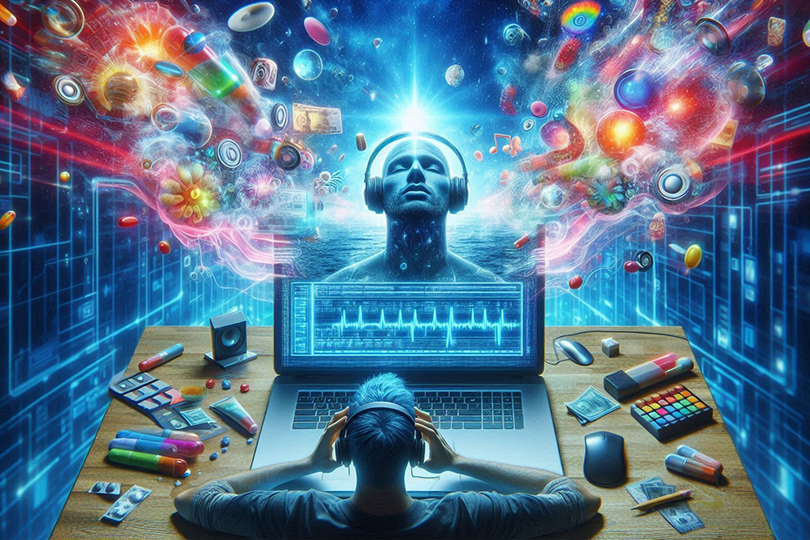By Dr. Samer Moayad Abdul Latif
Despite their many benefits, digital technologies have disfigured the beauty of our lives. On the ruins of innocent hopes and dreams, the reign of illusion and deception now prevails. Within its traps, the values of good and evil, beauty and ugliness, have become entangled. Under the weight of these shifting changes, even the most solid principles have crumbled. Sin now wraps itself in the most radiant of cloaks, unsettling human balance and obscuring the compass of truth.
Today, digital technology weaves for us, from threads of illusion, the most dazzling garments of false happiness. It plays melodies of deception, crafting the most beautiful hymns of loss, psychosis, and addiction—all under the guise of “digital drugs.” These are audio tracks or apps that deliver slightly different frequencies to each ear, generating the illusion of a third frequency in the brain. These so-called "binaural beats" are believed to influence brainwaves, inducing states of relaxation, euphoria, poor concentration, hallucinations, seizures, and increased breathing and heart rate—effects similar to traditional narcotics.
More precisely, these digital drugs are a new technological trend and a devilish invention that cunningly transcends the limitations of matter, sovereignty, security control, and even the moral burdens that restrict traditional drugs. Exploiting human curiosity and the private digital spaces individuals inhabit—far from parental oversight—and armed with misleading, unscientific claims about their safety (since they are not chemical substances), these "drugs" infiltrate the human mind through the ears or eyes, seducing emotions with varying rhythms or images. They captivate the user to the point of obsession, pulling them into a vortex of addiction and immersion in a virtual world with no escape or salvation.
The relative novelty of digital drugs and the lack of comprehensive studies on their effects have led to differing scientific opinions. There is still no definitive scientific evidence confirming their alleged impact. Most available claims stem from personal anecdotes or marketing hype rather than rigorous research. Some scientists cautiously argue that digital drugs are harmless tools for entertainment, mood enhancement, or improved sleep and focus. However, the majority warn that they may become a new tool of addiction, particularly among young people seeking unconventional experiences of euphoria and escape from a harsh reality.
The real danger of digital drugs lies not in the fingertip but deep within the psyche and emotions. Their long-term, subliminal influence can cause significant psychological harm, especially with excessive and uncontrolled use. Reported side effects include anxiety, depression, sleep and focus disturbances, hearing damage, tinnitus, and in some cases, epilepsy. Even worse, failure to achieve the desired effect may lead some users to try real drugs.
What makes the threat even more dire is the near impossibility of tracking or identifying these drugs hidden among millions of audio files online. Detecting them requires complex electronic audio analysis. Moreover, most countries have not yet criminalized digital drugs, save for a few isolated warnings against specific websites. The core challenge lies in proving intent, direct harm, or real-time effect—especially since these digital substances often require prolonged and intense exposure to manifest harm.
So how can we protect ourselves from this looming danger?
The first step is rooted in strong personal will and a desire to resist. A firm resolve remains the best defense against any form of addiction—even more than a treatment method for those already affected. Following this, raising awareness about the risks of digital addiction becomes essential. Families, schools, media outlets, and civil society organizations must launch awareness campaigns about digital drug dangers and how one can fall prey to them.
Self-monitoring, parental control, and governmental oversight must work together to detect risks, set boundaries, and alert the public. Constructive dialogue, promoting ethical and spiritual values, and presenting positive role models are crucial. Encouraging healthy alternatives like sports, meditation, listening to Quranic recitations, and other spiritually nourishing practices—sourced from known and trusted origins—can help those lost in the sweetness of the virtual world. Providing psychological support to those overwhelmed by harsh realities is also key to preventing relapse or digital escapism.
In conclusion, we urge concerned authorities—and the scientific community in particular—to conduct further in-depth research into the real effects of these audio clips and identify their potential dangers. Prevention starts with knowledge, and treatment begins with acknowledging the problem before it spirals out of control. Finally, we call on governments to enforce tighter monitoring and outright bans on suspicious websites that promote these digital drugs, criminalize their content, and punish those who promote them.






Comments